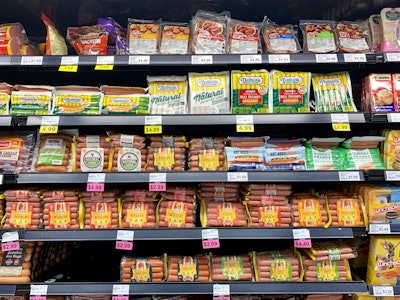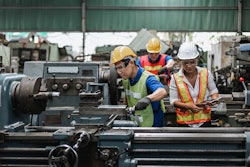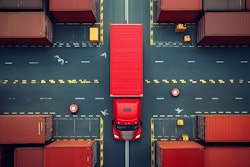
Picture a grocery store at peak hours: shoppers navigate packed aisles, employees restock shelves, and managers ensure everything runs smoothly. Behind this vibrant scene lies an intricate orchestration of logistics that ensures every item is available in the right amount, at the right time, and at the right price.
Keeping food-drug-mass retail stores merchandised according to plan is a massive undertaking that engages about 9.2 million workers in the United States, based on data from the 2022 US Census Bureau. The scale is staggering: North American supermarkets alone oversee 1.44 trillion SKUs daily. Even a minor 5% error in execution results in 72 billion issues per day.
Retailers invest millions in category management, promotions, and inventory optimization, yet inefficiencies persist. IHL Group data notes retailers miss out on nearly $1 trillion in sales each year from out-of-stock items. The challenge isn’t only about inventory, it’s about visibility, control, and execution at scale.
The role of robotics in retail efficiency
Retailers increasingly turn to automation to address these long-standing challenges. Robotics and artificial intelligence (AI)-driven solutions offer a precise, scalable solution to enhance execution and optimize store performance. McKinsey estimates that 50% of retail tasks can currently be automated, and retailers expect 70% of routine store duties to have an automation solution in place by 2025. In fact, hundreds of AI-enabled robots are already working in store aisles to optimize inventory functions. These technologies don’t replace human workers; they amplify their ability to focus on tasks that require judgment and customer engagement while automating the tedious, repetitive checks crucial for success.
For every item, in every store, retailers are tasked with four core execution challenges:
- On-shelf availability
Automated systems continuously monitor stock levels to prevent lost sales from out-of-stock products. Out-of-stocks have increased by a staggering 17.7% from 2022, with empty shelves rising by 22.8% ($29.6 billion), according to an IHL Retail Inventory Distortion Report.
- Planogram compliance
Robots use computer vision to compare actual shelf arrangements to planograms, ensuring adherence to category strategies. When done correctly, achieving planogram compliance has been shown to boost profits by 8.1%, according to the National Association of Retail Marketing Services.
- Price label accuracy
Autonomous systems verify that shelf prices match the price book and promotional discounts, reducing pricing errors that erode trust, revenue, and ensure compliance with state pricing transparency regulations.
- Display promotion execution
Retailers lose nearly a quarter of retail sales due to poor execution. Robots confirm whether promotional displays are properly implemented, maximizing effectiveness.
A shift to proactive retail execution
Traditional retail execution relies heavily on reactive corrections with store teams identifying problems after they’ve already affected sales. Robots flip this model, enabling proactive adjustments through continuous, consistent automated monitoring. This helps ensure on-shelf availability, pricing accuracy, optimal shelf organization, and promotional compliance at scale.
McKinsey estimates AI can reduce inventory carrying costs by 20% and stockouts by up to 50%. Real-world implementations show significant efficiency gains. Retailers using autonomous shelf-scanning robots report reduced out-of-stock incidents, faster price discrepancy corrections, and better compliance with merchandising standards. Additionally, by eliminating the burden of repetitive audits, store associates can shift focus to customer engagement and high-impact operational tasks.
Growing investments in robotics
Retailers are increasing their investment automation. A 2024 report by Progressive Grocer found that 25% of retailers were actively exploring in-store robotics, while 23% planned to adopt electronic shelf labels (ESLs) within 18 months. ESLs and robotics, when combined, create a synchronized system where price adjustments happen in real time, ensuring accurate promotions without the manual workload of updating paper tags.
According to Market.us, the Global Food Robotics Market is projected to grow from $3 billion in 2023 to around $8.9 billion by 2033, highlighting the growing dependence on automation within the food and grocery retail industries. However, automation isn’t without challenges. Implementation requires alignment between corporate strategy, store operations, and supply chain partners. Success depends on integration with existing retail technologies, a clear change management strategy, and a workforce trained to leverage automation effectively.
Additionally, ongoing support during and after deployment is critical. Continuous monitoring, troubleshooting, and updates ensure the system remains optimized and adaptable to any future changes or challenges.
Retailers embracing robotics and AI-driven automation position themselves to lead in an era where executional precision defines success. Those relying solely on human-driven execution risk falling behind as competitors leverage real-time intelligence to optimize inventory, pricing, and merchandising at an unprecedented scale.
AI-powered insights
Beyond just collecting data, AI-powered analytics can refine and improve execution and accuracy. With the treasure trove of data shelf scanning robots collect, machine learning algorithms can be applied to predict when stockouts are likely to occur, detect patterns in pricing errors, and suggest optimal product placements based on consumer behavior. Retailers implementing these tools gain the ability to anticipate challenges before they arise, further reducing operational inefficiencies.
For instance, AI tools analyze historical sales trends and environmental factors, such as holidays or regional demand shifts, to automate restocking schedules. This predictive approach not only improves inventory accuracy, but also enhances profitability by minimizing waste and maximizing sales potential.
Where we’re headed
The integration of robotics, AI, and data-driven decision-making marks the beginning of a new era in retail. The most successful retailers will be those that embrace these advancements and use them to create a seamless, highly efficient ecosystem.
Looking ahead, the role of automation in retail will continue to expand. The next wave of innovations will likely focus on autonomous checkout solutions, robotic-assisted order fulfillment, and even AI-driven customer personalization. As these technologies become more sophisticated, retailers that adopt them will gain a significant competitive edge in an increasingly complex market.
Retail has always been a detail-driven business. The retailers harnessing automation to master detail will not only solve today’s execution challenges but also build a resilient, data-powered foundation for the future. The trillion-item puzzle isn’t getting smaller, but with robotics, solving it is becoming far more achievable.




















